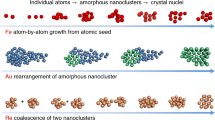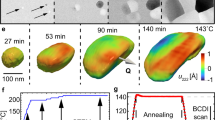Abstract
Ion implantation is widely used to introduce electrically or optically active dopant atoms into semiconductor devices1. At high concentrations, the dopants can cluster and ultimately form deactivating precipitates2,3, but deliberate nanocrystal formation offers an approach to self-assembled device fabrication. However, there is very little understanding of the early stages of how these precipitates nucleate and grow1, in no small part because it requires imaging an inhomogenous distribution of defects and dopant atoms buried inside the host material. Here we demonstrate this, and address the long-standing question of whether the cluster nucleation is defect-mediated or spontaneous. Atomic-resolution illustrations are given for the chemically dissimilar cases of erbium and germanium implanted into silicon carbide. Whereas interstitial loops act as nucleation sites in both cases, the evolution of nanocrystals is strikingly different: Erbium is found to gather in lines, planes and finally three-dimensional precipitates, whereas germanium favours compact, three-dimensional structures.
This is a preview of subscription content, access via your institution
Access options
Subscribe to this journal
Receive 12 print issues and online access
$259.00 per year
only $21.58 per issue
Buy this article
- Purchase on Springer Link
- Instant access to full article PDF
Prices may be subject to local taxes which are calculated during checkout




Similar content being viewed by others
References
Fahey, P.M., Griffin, P.B. & Plummer, J.D. Point defects and dopant diffusion in silicon. Rev. Mod. Phys. 61, 289–384 (1989).
Fair, R.B. & Weber, G.R. Effect of complex formation on diffusion of arsenic in silicon. J. Appl. Phys. 44, 273–279 (1973).
Chadi, D.J. et al. Fermi-level pinning defects in highly n-doped silicon. Phys. Rev. Lett. 79, 4834–4837 (1997).
Choyke, W.J. & Patrick, L. Photoluminescence of radiation defects in cubic SiC: localized modes and Jahn-Teller effect. Phys. Rev. B 4, 1843–1847 (1971).
Greulich-Weber, S. EPR and ENDOR investigations of shallow impurities in SiC polytypes. Phys. Status Solidi A 162, 95–151 (1997).
Spitznagel, J.A. et al. Ion beam modification of 6H/15R SiC crystals. Nucl. Instrum. Methods B 16, 237–243 (1986).
Lhermitte-Sebiret, I., Vicens, J., Chermann, J.L., Levalois, M. & Paumier, E. Transmission electron microscopy and high-resolution electron microscopy studies of structural defects induced in 6H a-SiC single crystals irradiated by swift Xe ions. Phil. Mag. 69, 237–253 (1994).
Lebedev, O.L., Van Tendeloo, G., Suvorova, A.A., Usov, I.O. & Suvorov, A.V. HREM study of ion implantation in 6H-SiC at high temperatures. J. Electron. Microsc. 46, 271–279 (1997).
Heera, V., Reuther, H., Stoemenos, J. & Pecz, B. Phase formation due to high dose aluminum implantation into silicon carbide. J. Appl. Phys. 87, 78–85 (2000).
Kaiser, U. Nanocrystal formation in hexagonal SiC after Ge ion implantation. J. Electron. Microsc. 50, 251–263 (2001).
Voyles, P.M., Muller, D.A., Grazul, J.L., Citrin, P.H. & Gossmann, H.-J.L. Atomic-scale imaging of individual dopant atoms and clusters in highly n-type bulk Si. Nature 416, 826–829 (2002).
Muller, D.A. & Grazul, J. Optimizing the environment for sub-0.2 nm scanning transmission electron microscopy. J. Electron. Microsc. 50, 219–226 (2001).
Batson, P.E. Simultaneous STEM imaging and electron energy-loss spectroscopy with atomic column sensitivity. Nature 366, 727–728 (1993).
Browning, N.D., Chisholm, M.M. & Pennycook, S.J. Atomic-resolution chemical analysis using a scanning transmission electron microscope. Nature 366, 143–146 (1993).
Muller, D.A. et al. The electronic structure at the atomic scale of ultra-thin gate oxides. Nature 399, 758–761 (1999).
Loane, R.F., Kirkland, E.J. & Silcox, J. Visibility of single heavy atoms on thin crystalline silicon in simulated annular dark field. Acta Crystallogr. A 44, 912–927 (1988).
Howie, A. Image contrast and localized signal selection techniques. J. Microsc. 17, 11–23 (1979).
Pennycook, S.J. Z Contrast STEM for materials science. Ultramicroscopy 30, 58–69 (1989).
Perovic, D.D., Rossow, C.J. & Howie, A. Imaging elastic strains in high-angle annular dark-field scanning-transmission electron microscopy. Ultramicroscopy 52, 353–359 (1993).
Hillyard, S.E. & Silcox, J. Detector geometry, thermal diffuse scattering and strain effects in ADF STEM imaging. Ultramicroscopy 58, 6–17 (1995).
Weissker, H.C., Furthmüller, J. & Bechstedt, F. First-principles of optical properties: application to embedded Ge and Si dots. Phys. Status Solidi B 224, 769–773 (2001).
Choyke, W.J., Devaty, R.P., Clemen, L.L. & Yoganathan, M. Intense erbium-1.54-μm photoluminescence from 2 to 525 K in ion-implanted 4H, 6H, 15R and 3C SiC. Appl. Phys. Lett. 65, 1668–1670 (1994).
Wesch, W., Heft, A., Wendler, E., Bachmann, T. & Glaser, E. High temperature ion implantation of silicon carbide. Nucl. Instrum. Methods B 96, 335–338 (1995).
Choyke, W.J., Matsunami, H. & G., P. Silicon Carbide (Wiley-VCH, Berlin, 1997).
Tairov, Y.M. & Vodakov, Y.A. in Group IV Materials (ed. Pankove, J.I.) 35 (Springer, New York, 1977).
Usov, I.O., Suvorova, A.A., Sokolov, V.V., Kudryavtsev, Y.A. & Suvorov, A.V. Transient enhanced diffusion of aluminum in SiC during high temperature ion implantation. J. Appl. Phys. 86, 6039–6042 (1999).
Skorupa, W., Heera, V., Pacaud, Y. & Weishart, H. Ion beam processing of single crystalline silicon carbide. Nucl. Instrum. Methods B 120, 114–120 (1996).
Brown, L.M., Allen, G. & Flewitt, P. Nanochemistry of grain boundaries. Phys. World 45–50 (May, 1997).
Acknowledgements
We are grateful to Jim Choyke and Igor Khodos for discussions and Christian Schubert and Gunnar Pasold for ion implantation and annealing. This work has been supported by the German Foundation DFG SFB 196.
Author information
Authors and Affiliations
Corresponding author
Ethics declarations
Competing interests
The authors declare no competing financial interests.
Supplementary information
FIGURE 1 A typical SiC matrix defect decorated by Er-atom columns together with the EELS spectrum of the Er M edge obtained from the single Er atom column the arrow is pointing to.
FIGURE 2. An expanded view of the accordion or 'christmas-tree'-like Er cluster of Fig. 3c.This is a commonly observed Er structure. From the image contrast, each brighter dot contains approximately 10 or so Er atoms, so this is an end of view of a two-dimensional Errich platelet. (PDF 950 kb)
FIGURE 3 HRTEM images of the dislocations at the edge of interstitial loops — (a) before and (b) after annealing for 180° sec at 1600 °C. Lattice bending maps showing the origins of the strains for (a) & (b) are shown in (c) & (d) respectively. (e) HAADF image of a dislocation before annealing.The white spots are isolated Er atoms scattered randomly about the matrix — none has yet segregated at the dislocation core. (f) After annealing the Er has segregated to the dislocations, and very little remains in the matrix. HRTEM from a JEOL 3010, HAADF from a JEOL 2010F.
Rights and permissions
About this article
Cite this article
Kaiser, U., Muller, D., Grazul, J. et al. Direct observation of defect-mediated cluster nucleation. Nature Mater 1, 102–105 (2002). https://doi.org/10.1038/nmat729
Received:
Accepted:
Published:
Issue Date:
DOI: https://doi.org/10.1038/nmat729
This article is cited by
-
Modified qHAADF method for atomic column-by-column compositional quantification of semiconductor heterostructures
Journal of Materials Science (2019)
-
Precipitation of binary quasicrystals along dislocations
Nature Communications (2018)
-
In Situ Atom Scale Visualization of Domain Wall Dynamics in VO2 Insulator-Metal Phase Transition
Scientific Reports (2014)
-
Atom-resolved imaging of ordered defect superstructures at individual grain boundaries
Nature (2011)
-
New distribution formulas for classical gas, clusters, and phase transitions
Theoretical and Mathematical Physics (2008)



